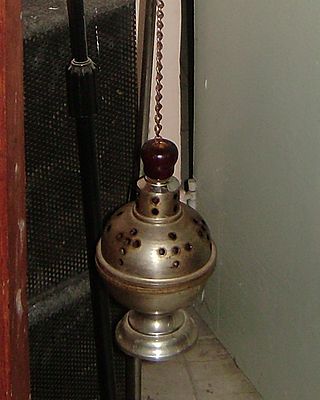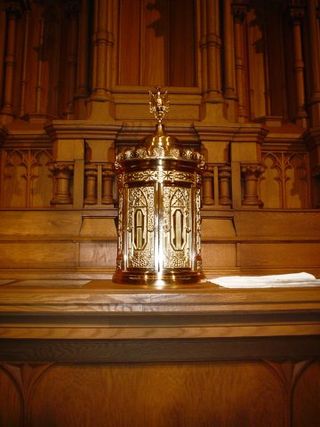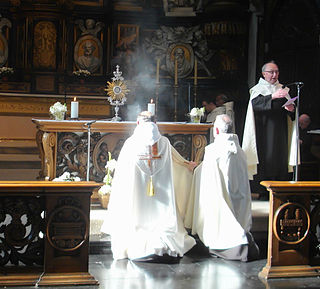
A thurible is a metal censer suspended from chains, in which incense is burned during worship services. It is used in Christian churches including the Roman Catholic, Eastern Orthodox, Assyrian Church of the East and Oriental Orthodox, as well as in some Lutheran, Old Catholic, United Methodist, Reformed, Presbyterian Church USA, and Anglican churches. In Roman Catholic, Lutheran, and Anglican churches, the altar server who carries the thurible is called the thurifer. The practice is rooted in the earlier traditions of Judaism in the time of the Second Jewish Temple.

Genuflection or genuflexion is the act of bending a knee to the ground, as distinguished from kneeling which more strictly involves both knees. From early times, it has been a gesture of deep respect for a superior. Today, the gesture is common in the Christian religious practices of the Anglicanism, Lutheranism, the Catholic Church, and Western Rite Orthodoxy. The Latin word genuflectio, from which the English word is derived, originally meant kneeling with both knees rather than the rapid dropping to one knee and immediately rising that became customary in Western Europe in the Middle Ages. It is often referred to as "going down on one knee" or "bowing the knee". In Western culture, one genuflects on the left knee to a human dignitary, whether ecclesiastical or civil, while, in Christian churches and chapels, one genuflects on the right knee when the Sacrament is not exposed but in a tabernacle or veiled.
The Confraternity of Christian Doctrine (CCD) is an association established in Rome in 1562 for the purpose of providing religious education. In modern usage, it refers to the Confraternity of Christian Doctrine, Inc., which owns the copyright on the New American Bible Revised Edition, and is a term colloquially used for the catechesis or religious education program of the Catholic Church, normally designed for children. In some Catholic parishes, CCD is called PSR, meaning Parish School of Religion, or SRE, meaning Special Religious Education.

Eucharistic adoration is a Eucharistic devotional practice primarily in Western Catholicism, but also to a lesser extent in certain Lutheran and Anglican traditions, in which the Blessed Sacrament is adored by the faithful. This practice may occur either when the Eucharist is exposed, or when it is not publicly viewable because it is reserved in a place such as a church tabernacle.

A tabernacle or a sacrament house is a fixed, locked box in which the Eucharist is stored as part of the "reserved sacrament" rite. A container for the same purpose, which is set directly into a wall, is called an aumbry.

Eucharistic discipline is the term applied to the regulations and practices associated with an individual preparing for the reception of the Eucharist. Different Christian traditions require varying degrees of preparation, which may include a period of fasting, prayer, repentance, and confession.

Peter Julian Eymard was a French Catholic priest and founder of two religious institutes: the Congregation of the Blessed Sacrament for men and the Servants of the Blessed Sacrament for women.
The Year of the Eucharist is the name of the liturgical year from October 2004 to October 2005, as celebrated by Catholics worldwide. On June 10, 2004, Pope John Paul II announced the dedication of an entire year to the Blessed Sacrament and invited the entire Church to reflect upon the Eucharist.

Benediction of the Blessed Sacrament, also called Benediction with the Blessed Sacrament or the Rite of Eucharistic Exposition and Benediction, is a devotional ceremony, celebrated especially in the Roman Catholic Church, but also in some other Christian traditions such as Anglo-Catholicism, whereby a bishop, priest, or a deacon blesses the congregation with the Eucharist at the end of a period of adoration.

The Confraternity of the Blessed Sacrament (CBS), officially the Confraternity of the Blessed Sacrament of the Body and Blood of Christ, is a devotional society in the Anglican Communion dedicated to venerating the Real Presence of Christ in the Eucharist. It has worked to promote the Mass as the main Sunday service in churches, regular confession, and the Eucharistic fast. The society's motto is Adoremus in aeternum sanctissimum sacramentum, or in English, "Let us forever adore the Most Blessed Sacrament".

During the Mass of the Faithful, the second part of the Mass, the elements of bread and wine are considered to have been changed into the veritable Body and Blood of Jesus Christ. The manner in which this occurs is referred to by the term transubstantiation, a theory of St. Thomas Aquinas, in the Roman Catholic Church. Members of the Orthodox, Anglican, and Lutheran communions also believe that Jesus Christ is really and truly present in the bread and wine, but they believe that the way in which this occurs must forever remain a sacred mystery. In many Christian churches some portion of the consecrated elements is set aside and reserved after the reception of Communion and referred to as the reserved sacrament. The reserved sacrament is usually stored in a tabernacle, a locked cabinet made of precious materials and usually located on, above, or near the high altar. In Western Christianity usually only the Host, from Latin: hostia, meaning "victim", is reserved, except where wine might be kept for the sick who cannot consume a host.

Eucharist is the name that Catholics give to the sacrament by which, according to their belief, the body and blood of Christ are present in the bread and wine that are consecrated during the Catholic eucharistic liturgy, generally known as the Mass. The definition of the Eucharist in the 1983 Code of Canon Law as the sacrament where Christ himself "is contained, offered, and received" points to the three aspects of the Eucharist according to Catholic theology: the real presence of Christ in the Eucharist, Holy Communion, and the holy sacrifice of the Mass.

Antonio Cañizares Llovera is a Spanish cardinal of the Roman Catholic Church who was the Archbishop of Valencia from 2014 to 2022. He was prefect of the Congregation for Divine Worship and the Discipline of the Sacraments from 2008 to 2014, and archbishop of Toledo and Primate of Spain from 2002 to 2008. He was made a cardinal in 2006.

The Congregation of the Blessed Sacrament, commonly known as the Sacramentinos is a Catholic Clerical Religious Congregation of Pontifical Right for men founded by St. Pierre-Julien Eymard. Its members use the nominal letters S.S.S. which is the acronym of its official name in Latin, after their names. By their life and activities, they assist the Church in her efforts to form Christian communities whose center of life is the Eucharist. They commit themselves to the implementation of this ideal in collaboration with lay men and women engaged in various ministries.
Forty Hours' Devotion, in Italian called Quarant'ore or written in one word Quarantore, is a Roman Catholic liturgical action in which continuous prayer is made for forty hours before the Blessed Sacrament in solemn exposition. It often occurs in a succession of churches, with one finishing prayers at the same time as the next takes it up.
The Tabernacle Societies were lay Eucharistic Adorative associations within Roman Catholic parishes, principally in America and Australia, forming part of the Archassociation of the Eucharist under the guidance of the Association of Perpetual Adoration of the Blessed Sacrament.
Servants of the Most Blessed Sacrament is a Roman Catholic religious institute of women, founded by the Venerable Pierre-Julien Eymard in 1858, assisted by Mother Margaret of the Blessed Sacrament, with the authorization of Mgr Morlot, Archbishop of Paris.

Thanksgiving after Communion is a spiritual practice among Christians who believe in the Real Presence of Jesus Christ in the Communion bread, maintaining themselves in prayer for some time to thank God and especially listening in their hearts for guidance from their Divine guest. This practice was and is highly recommended by saints, theologians, and Doctors of the Church.
This is a glossary of terms used within the Catholic Church. Some terms used in everyday English have a different meaning in the context of the Catholic faith, including brother, confession, confirmation, exemption, faithful, father, ordinary, religious, sister, venerable, and vow.

St Peter Julian's Church is a Roman Catholic church and shrine of eucharistic adoration in Sydney in the care of the Congregation of the Blessed Sacrament.











